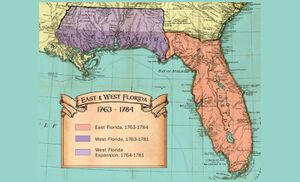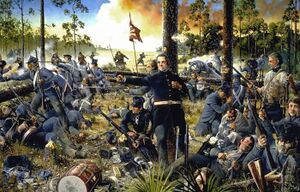How did Florida become a State
Florida was perhaps the first place in what is now the United States to have been reached by European settlers in 1513. The state was named for its verdant landscape by Spanish explorers. Over the next few centuries, Florida was mostly controlled by the Spanish Empire, although British control occurred between 1763-1783. In the early 19th century, Florida was controlled by the Spanish again but became a region the United States saw as problematic as it became a refuge for runaway black slaves and native Seminoles began to raid parts of the United States from the area. Soon this led to clashes and the beginning of how Florida became incorporated into the United States.
Contents
The First Seminole War
In 1763, during the period of British rule in Florida, the region that became the state was divided into two administrative areas, East and West Florida (Figure 1). The Apalachicola River was used as a dividing line and the region was seen as too large to be administered by one local government. In the early 1800s, Florida became a refuge for runaway slaves. Florida had no slavery policy and slaves saw Florida as a good refuge. Over time, as more slaves ran away to Florida, the Black Seminoles developed into another cultural group through. While some Seminoles did keep slaves, Black Seminoles and other slaves were generally free to live where they wanted even if they were technically slaves, with the Black Seminoles often living in separate villages from Seminole settlements. Since the 17th century, black slaves were running away to Florida to escape plantations to the north and over time many black slaves intermarried with Seminoles and other native groups. The continued practice of slaves finding refuge in Florida served as one motivation for the First Seminole War. The second key motivation were raids by Seminoles, although farmers and militia from southern states also raided Florida. The First Seminole War was effectively cross-border raids and an invasion led by Andrew Jackson between 1816-1819, with the conflict having no clear date when it actually began. The United States had wanted to acquire Florida during the time of the War of 1812. In fact, a detachment of soldiers had occupied St. Augustine, causing tensions with Spain. Black Seminoles had fought US soldiers and militia who had invaded, fearing they would take away their relatively greater freedom in Florida. A fort was created in northern Florida to help defend the territory and the so-called Scott Massacre of civilians, committed by native Creeks who were in conflict with the United States, and soldiers started the war that led to the invasion of Florida by Andrew Jackson. Jackson led a series of raids in 1818 against civilians and various native tribes. The militia and military unit Jackson led did not discriminate who they attacked and in May 1818 his forces took Pensacola, what was the capital of West Florida. Eventually Jackson withdrew after he was condemned within the United States and abroad. During the time of the conflict, the US had been in negotiation to acquire Florida and for a while the actions by Jackson caused Spain to stop negotiations. The conflict also left a stain on Jackson's reputation for having executed two British citizens without adequate trial.[1]
Florida Territory
Florida was eventually purchased by the United States in 1819 and became a territory in 1821. Jackson, despite earlier condemnation of his actions, was appointed military governor of Florida. The Seminole tribes continued to be a problem, at least seen by the now emigrating white settlers, in that there was no treaty governing where they could settle. The treaty of Treaty of Moultrie Creek was suppose to give central Florida as an area for Seminole tribes to settle, but tribes were generally unhappy as the United States effectively controlled goods, trade, and provisions needed to settle there. Runaway slaves continued to come to native lands and relations between Seminoles and the US government became worse. Many Seminoles refused relocation and skirmishes broke out between settlers, soldiers, and Seminoles. The conflict that became the Second Seminole War started in 1835-1842 started and became very costly to the United States. Seminoles fought against the United States and now also their Creek allies. The Dade Massacre and other guerilla attacks by the Seminoles proved effective for some time (Figure 2). In 1836, the United States sent General Thomas Jesup to fight the Seminoles. Realizing he could not defeat the Seminoles fighting their guerilla tactics, he decided to attack civilians in their villages and farmlands the Seminoles used for food. This starved and led to the Seminole population to be decimated. Finally, tricking the Seminole chiefs Osceola and Micanopy that Jesup wanted to make a peace treaty with them, Jesup instead captured the chiefs and had them executed, forcing the eventual surrender of the Seminoles. Many Seminoles were then relocated to Oklahoma, with a few remaining behind. Many Seminoles also died trying to reach Indian Territory (Oklahoma). Eventually, the conclusion of the war led to an influx of white settlers.[2]
Florida Becomes a State
In 1845 Florida became a state. By this time, most of the non-native population were enslaved blacks. William Dunn Moseley became the first governor and he saw a period of increased white settlement. By the 1850s, there was greater pressure to remove the remaining Seminoles to Indian Territory. Tensions between remaining Seminoles and settlers increased, while the presence of the US army scouts created tensions. Ft. Myers was also attacked by Seminoles in a raid but the main incident that start the Third Seminole War was when Billy Bowlegs, a Seminole chief, led a rain near Ft. Myers against a plantation in 1855. The last Seminole war lasted fro 1855-1858, which was a conflict of mostly raids. Once again, the US resorted to attacking settlements and destroying farmland to effectively starve the Seminoles. This worked and the Seminoles surrendered in 1858, with the remaining population removed to Indian Territory. Only a few Seminoles remained in the Everglades. By 1860, 44% of the population of Florida were slaves, with the state focusing on a plantation economy. During the Civil War, the Union occupied most of the major port towns of Florida, including Cedar Key, Jacksonville, and Key West. The only major battle was the Battle of Olustee that took place in Baker County that resulted in a Confederate victory, although it proved inconclusive in affecting the outcome of the war and presence of Union forces. Florida was readmitted into the Union in 1868 after accepting the 13th and 14th Amendments to the Constitution. Florida was about 44% African American by this time but voter suppression effectively meant that nearly the entire African American population was disenfranchised. During the Great Migration in the 20th century, the population began to change as the state continued to disenfranchise blacks and northern cities became a many attraction for the African American population.
Summary
The rise of Florida as a state was turbulent and was mostly characterized by conflict with initially Creek and later Seminole populations. The Seminoles were effective in practicing guerrilla warfare tactics but the destruction of their civilian infrastructure and population led to their eventual removal from Florida, leading to the state becoming a major plantation state. Florida was heavily populate by slaves and eventually freed African Americans, but African Americans were mostly disenfranchised and segregated until the 1960s civil rights movement.
References
- ↑ For more on the period up to the First Seminole War in Florida's history, see: Wasserman, Adam. A People’s History of Florida, 1513-1876: How Africans, Seminoles, Women, and Lower Class Whites Shaped the Sunshine State. Sarasota, Fla.: A. Wasserman, 2010.
- ↑ For more on the period when the state becomes a territory and up through the Second Seminole War, see: Knetsch, Joe. Florida’s Seminole Wars, 1817-1858. Charleston, SC: Arcadia Pub. Co., 2003. http://www.aspresolver.com/aspresolver.asp?LRHO;73852424.

